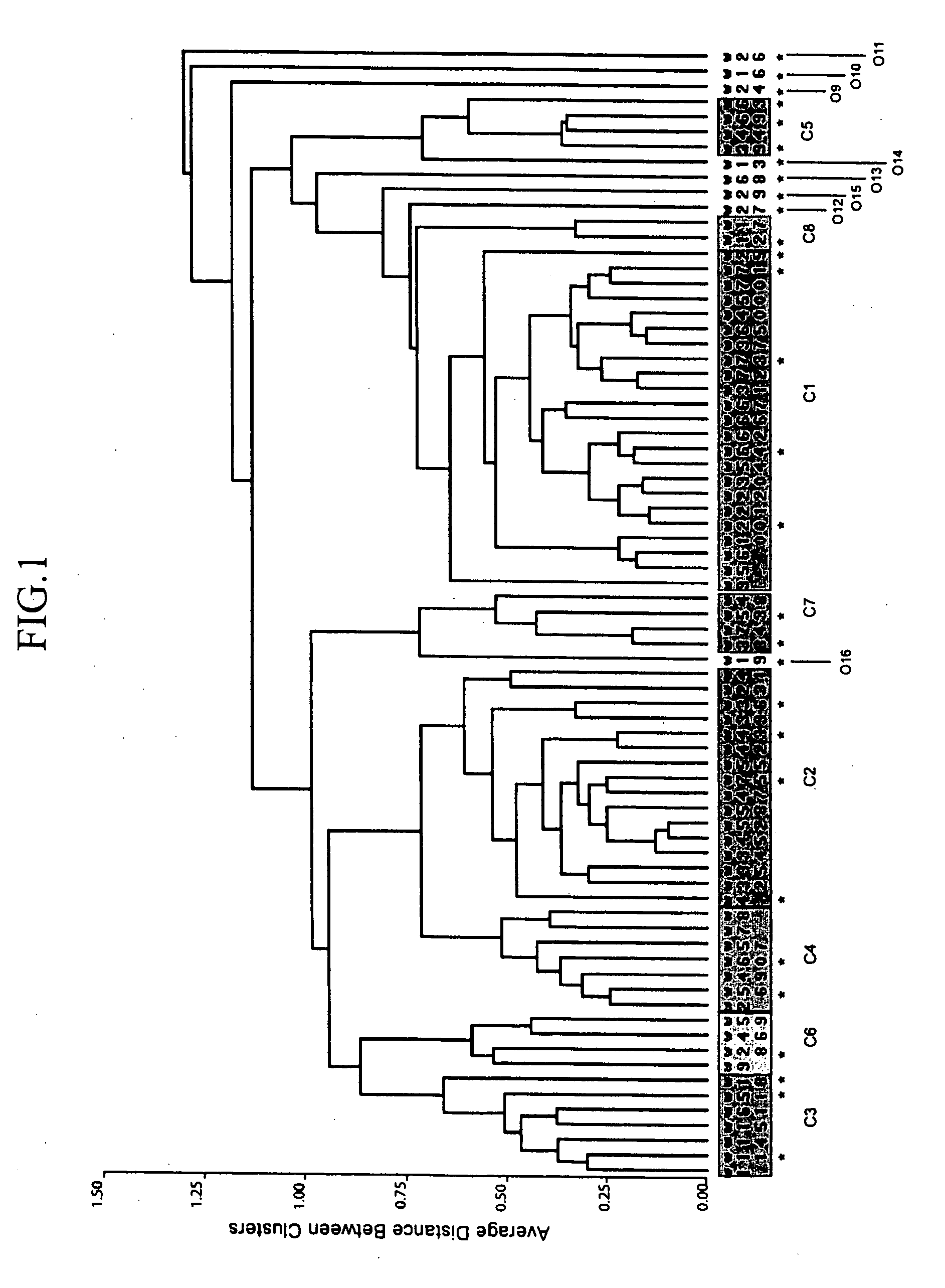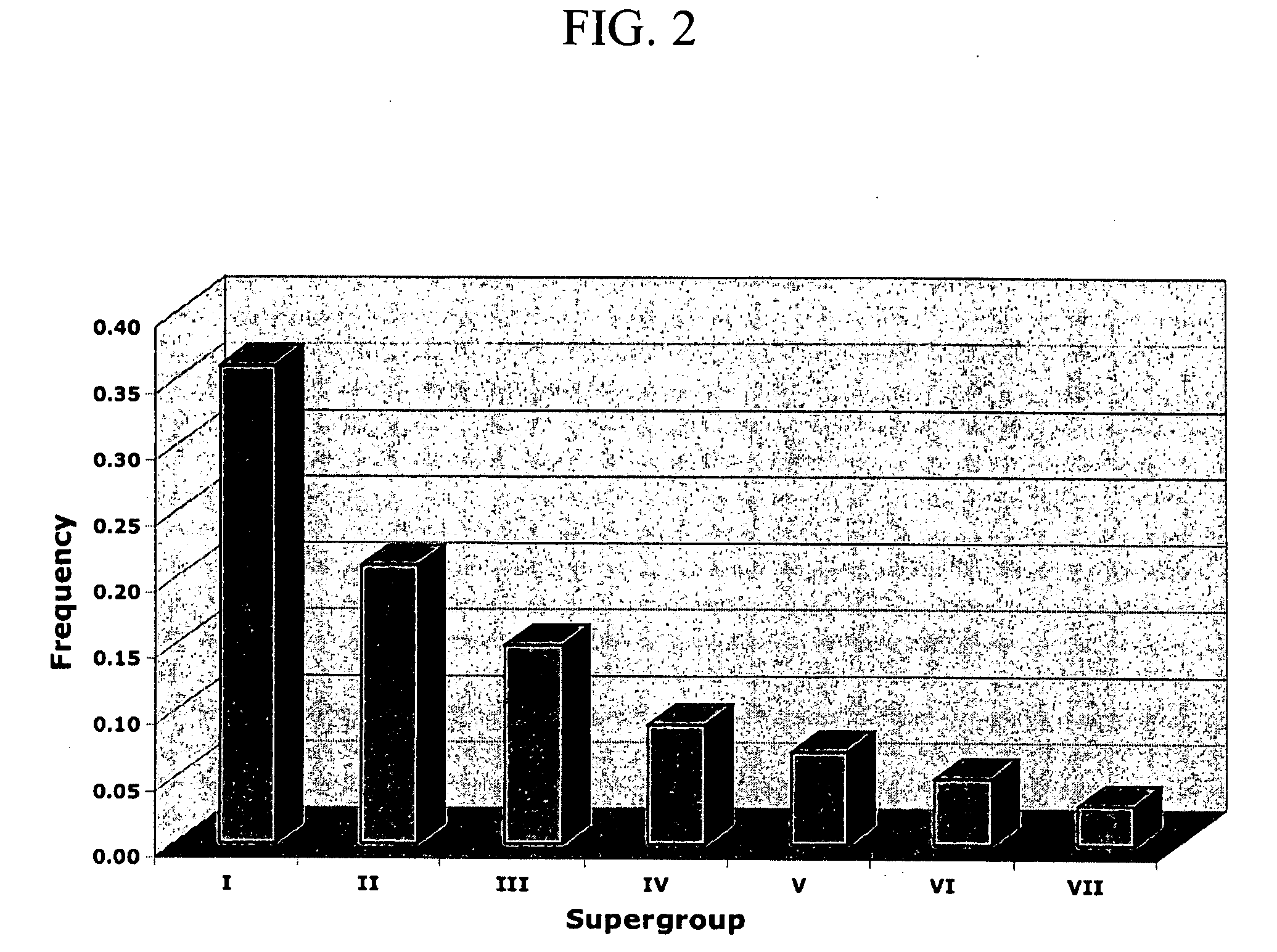Categorization of microbial communities
a technology of microorganisms and communities, applied in the field of microorganism ecology, can solve the problems of indirect evidence for the excretion of hydrogen peroxide in vivo, inability to solve paradoxes, and inability to identify and categorize populations of microorganisms
- Summary
- Abstract
- Description
- Claims
- Application Information
AI Technical Summary
Problems solved by technology
Method used
Image
Examples
example 1
Categorization of Normal Vaginal Microbiota in Five Women
[0198] Cultivation-independent methods were used to analyze samples collected at multiple time points over a 2-month period from the mid-vagina of normal healthy women. The species composition and structure (proportion of each species) of each community was assessed.
[0199] In brief, total microbial community DNA was isolated from microbial cells that had been retrieved on vaginal swabs. Genomic DNA was isolated from 0.5 ml aliquots of the cell suspensions using a two-step cell lysis procedure. First, bacterial cell walls were disrupted enzymatically by the addition of mutanolysin (50 μg) and lysozyme (500 μg) followed by incubation for 1 hour at 37° C. Secondly, the cells were mechanically disrupted by 6 freeze-thaw cycles. Each cycle consisted of 2 minutes incubation at 100° C. that was immediately followed by 2 minutes in liquid nitrogen. Between each freeze-thaw cycle, the cell suspensions were incubated for 1 minute in a...
example 2
Categorization of Normal Vaginal Microbiota in Caucasian Women
[0206] Mid-vaginal samples from 75 normal and healthy North American Caucasian women between the ages of 13-40 years were analyzed. Samples were selected so that a total of 15 samples were drawn from each of five geographic locations: Manitoba, New Jersey, Ohio, Florida, and Arizona. Within each geographic group there was an equal number of women from each of three age groups: 13-18, 19-35, and 36-40 years old.
[0207] Vaginal specimens were collected using a sterile swab inserted into the vagina. Samples were taken near the cervix using a saline-lubricated speculum to minimize contamination by the flora of the labia during entry and withdrawal of the swab. Swabs were placed in a labeled cryovial and stored at −70° C. until analysis.
[0208] A tiered approach for sample analysis was used to assess the structure of vaginal microbial communities. Statistical analyses were used to winnow the data and insure that samples repre...
example 3
Categorization of Normal Vaginal Microbiota in African-American Women
[0231] Disparities in the incidence of BV and sexually transmitted diseases among racial groups have been well documented. BV occurs in 17-19% of all female patients attending family practice clinics. However the incidence among minority (Black and Mexican-American) women exceeds 50%. To improve diagnostic and patient management capabilities, the identity of the dominant bacterial populations of healthy Black women using cultivation-independent methods was determined and compared to the bacterial populations in healthy White women.
[0232] Seventy randomly selected vaginal samples obtained from (self-declared) Black subjects were selected for analysis. Fifteen samples from four geographic sites in the United States were chosen (Cincinnati, Ohio; East Brunswick, N.J.; St. Petersburg, Fla. and Scottsdale, Ariz.), and within each geographic group there were equal numbers of women from each of three age groups: 13-18, ...
PUM
| Property | Measurement | Unit |
|---|---|---|
| Fraction | aaaaa | aaaaa |
| Fraction | aaaaa | aaaaa |
| Fraction | aaaaa | aaaaa |
Abstract
Description
Claims
Application Information
 Login to View More
Login to View More - R&D
- Intellectual Property
- Life Sciences
- Materials
- Tech Scout
- Unparalleled Data Quality
- Higher Quality Content
- 60% Fewer Hallucinations
Browse by: Latest US Patents, China's latest patents, Technical Efficacy Thesaurus, Application Domain, Technology Topic, Popular Technical Reports.
© 2025 PatSnap. All rights reserved.Legal|Privacy policy|Modern Slavery Act Transparency Statement|Sitemap|About US| Contact US: help@patsnap.com



